María Dueñas: November Musician of the Month
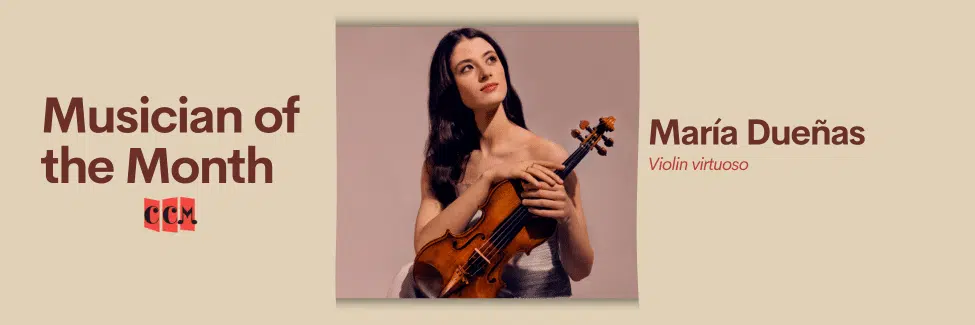
This November, we are proud to spotlight María Dueñas as our Musician of the Month at the California Conservatory of Music (CCM). María is a violin virtuoso that captivates audiences with her musicality and profound emotional depth. Her performances seamlessly blend technical precision with passionate expression, setting her apart in the world of classical music.
Early Life and Inspirations
María grew up surrounded by a family that cherished musical traditions, immersing her in music from a young age. She took up the violin early, instantly drawn to its complex and emotive capabilities. Inspired by violin legends like Itzhak Perlman and Hilary Hahn, she pursued rigorous training, showcasing an innate talent for the instrument. Her early exposure to a range of musical styles fueled a deep love for both classical and contemporary works, shaping her future as a versatile and dynamic performer.
María’s Musical Career Highlights
María’s career is a testament to her dedication and skill. She has performed with renowned orchestras across the globe, earning accolades for her vibrant and nuanced performances. Her journey through music competitions has earned her numerous awards, highlighting her as a standout talent in her generation. Each performance by María not only displays her technical prowess but also her ability to connect deeply with her audience, making each concert a memorable event.
Unique Aspects of Marías’s Music
What truly sets María apart is her approach to music as a form of storytelling. She interprets each piece as a narrative, using her violin to convey emotions and stories that resonate with listeners. Her commitment to exploring the expressive potential of music leads her to experiment with sound and technique, pushing the boundaries of traditional violin playing. This exploratory spirit is evident in her performances, which are both innovative and grounded in classical expertise.
Notable Performances and Recordings
Among her many achievements, María’s interpretation of Tchaikovsky’s Violin Concerto has been particularly celebrated for its emotional intensity and technical mastery. Her recordings, including works by Mendelssohn and Paganini, showcase her adaptability and flair for bringing new life to classical compositions. These recordings have not only captivated classical music enthusiasts but have also garnered critical acclaim, further establishing her as a leading figure in the music world. Check out María’s performance Mendelssohn’s Concerto in E minor.
Final Thoughts
María Dueñas is more than just a musician; she is an artist who paints with notes and rhythms. Her contribution to the world of music is immense, inspiring current and future generations of musicians. As CCM celebrates her as the Musician of the Month, we invite everyone to delve into her musical world and experience the power and beauty of her performances. María’s journey underscores the transformative power of music and the heights that can be reached with passion and perseverance.
Sign up for your FREE introductory music lesson at The California Conservatory of Music!

Extracurricular Activities: Balancing School and Music Lessons
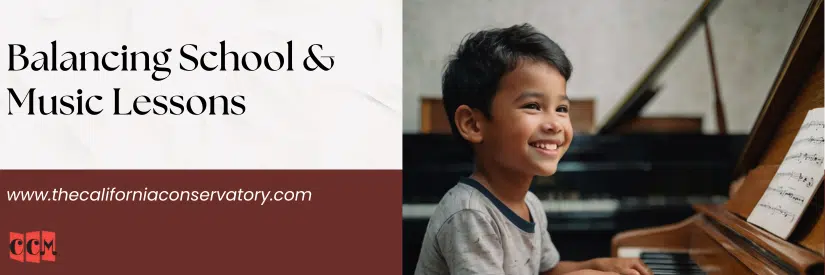
In today’s fast-paced educational environment, balancing school with extracurricular activities can be a challenge for many students and their families. Music lessons, a popular choice among extracurricular activities, offer profound benefits while requiring time and dedication. This blog explores effective strategies to balance school responsibilities with music lessons, ensuring students can thrive in both arenas!
Benefits of Music Lessons as an Extracurricular Activity
Music lessons are more than just an artistic outlet; they provide a range of benefits that support academic and personal growth. Engaging in music improves cognitive abilities, enhances time management skills, and fosters emotional expression. These skills are invaluable, not only academically but in overall personal development. By recognizing the dual benefits of music as an extracurricular activity, families can appreciate the importance of maintaining this balance.
Setting Realistic Goals
Balancing school and music lessons starts with setting realistic goals. Students should outline clear, achievable objectives for both their academic and musical pursuits. This might involve scoring well on tests or reaching the next book level in music lessons. By setting goals, students can monitor their progress and adjust their efforts in school and music lessons accordingly.
Effective prioritization is key in managing school and extracurricular activities. Students should identify which tasks require immediate attention and which can wait. For instance, during recital season, you may try to fit more music practice into your schedule so that you feel prepared to perform. Learning to prioritize helps students reduce stress and focus on tasks that require the most attention.
Creating a Structured Schedule
A well-planned schedule is crucial to balance school and music lessons effectively. Students should allocate specific times for homework, study, music practice, and relaxation. This structure prevents overcommitment and ensures that students have ample time for both academic and musical growth. Utilizing planners or digital calendars can help keep track of assignments and upcoming music recitals, making it easier to manage time effectively. Consider a reward system as well to keep students excited to practice and learn more in school!
Utilizing Activity Resources & Communication
Open communication with school teachers and music instructors can facilitate better balance. Informing them about each other’s schedules and significant deadlines can help them understand the student’s commitments. Teachers and instructors often can provide guidance on managing workload and might even coordinate to support the student’s needs. Many schools offer resources that can help students balance their coursework with extracurricular activities. Tutoring, study groups, and academic counseling are valuable resources that can help manage schoolwork more efficiently. At the California Conservatory of Music, we have a great practice incentive program! Our program includes practice streaks: kids can get medals, and certificates for consistently practicing, homework sheets and practice points, and the Practice Space App! Taking advantage of these resources can free up more time for music practice and reduce academic pressure. Ask about CCM’s practice incentives!
Learning Efficient Practice Techniques
For students balancing school and music lessons, effective time management is crucial. The Pomodoro Technique is especially useful; dedicate 25-minute blocks to tackling specific challenges, such as a difficult music passage or a complex math problem, followed by a 5-minute break to reset. Utilize technology to streamline practice—apps like metronomes for musicians and flashcard tools for academics can enhance productivity. Aim for short, frequent review sessions rather than lengthy, infrequent ones, as this helps reinforce material more effectively. Above all, consistency is key; regular, focused practice sessions contribute to significant improvements in both academic and musical pursuits, making the balancing act more manageable and less stressful.
Final Thoughts
Balancing school with music lessons, like any extracurricular activities, demands careful planning, communication, and prioritization. By adopting structured schedules, setting realistic goals, and using efficient study techniques, students can excel in their academic and musical endeavors. Ultimately, the goal is to enjoy and benefit from both educational experiences without compromising on either.
Sign up for a FREE introductory music lesson at The California Conservatory of Music!

Guitar & Voice Students of the Month – Sharvari & Arjun
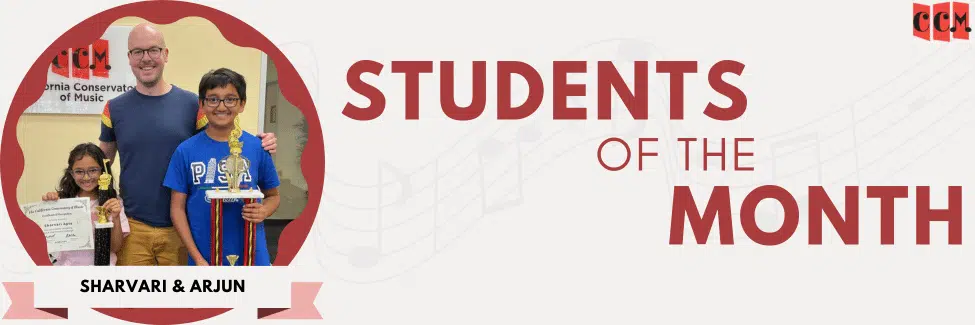
For September and October, we’ve chosen to spotlight CCM voice and guitar students, Sharvari and Arjun, as our Students of the Month! Arjun has been taking guitar lessons at CCM for 8 years now and currently studies with teacher Tim at our Sunnyvale location. Arjun’s sister, Sharvari, has been taking guitar lessons for 5 years, also with teacher Tim. She also has been taking voice lessons for 3 years and currently studies with Teacher Nyla. Sharvari and Arjun are extremely dedicated students and each one of their previous and current teachers has truly enjoyed teaching them! Sharvari recently completed 4 years of consecutive guitar practice and Arjun completed 8 years – Congratulations!!
Student of the Month Questionnaire – Sharvari and Arjun
What is your name?
Sharvari
Arjun
How old are you?
Sharvari: 8 years old
Arjun: 13 years old
Who is your teacher?
Arjun: Teacher Tim (guitar lessons)
Sharvari: Teacher Tim (guitar lessons), Teacher Nyla (current voice teacher), Teacher Orlia and Teacher Gaby (past voice teachers)
How long have you been taking guitar lessons?
Arjun: for 8 years
Sharvari: for 5 years
How long have you been taking voice lessons?
Sharvari: for 3 years
What advice would you give to a student just starting at CCM?
Sharvari: Keep on practicing
Arjun: Never give up
What piece are you looking forward to learning someday?
Arjun: Xaranga Do Vovo by Celso Machado
Sharvari: Bourrée by L. Mozart (Suzuki Book 4)
What is your favorite thing about playing your instrument?
Arjun: I enjoy the sound of guitar
Sharvari: It is fun to play new music pieces
What is your favorite food?
Arjun: Pizza
Sharvari: Lasagna
Do you have a pet?
No
Do you play any sports or do any other activities outside of music lessons?
Arjun: I enjoy playing tennis and swimming, and I play trumpet in our school’s band
Sharvari: I have been learning an Indian classical dance form called Kathak and I play tennis and do Taekwondo.
What do you want to be when you grow up?
Arjun: Doctor
Sharvari: Author
What is your most memorable experience at CCM?
Arjun: Playing at my first ever recital
Sharvari: Participating at CCM recitals
Parent Spotlight – Atul and Smruti
We are most proud of their dedication to daily practice. The practice incentives at CCM and encouragement from Teacher Tim established a great foundation to make daily practice a habit. Their guitars have accompanied them even at Disneyland and for overseas travel to Europe and India.
Trust the methodology of the CCM teachers (they are great at what they do) and encourage your child to practice daily (even 5 mins of focused practice counts).
We believe that music is a good way to generate happiness within and around you. We felt that an early and constant exposure to classical music would build a love for it and would hopefully help them in the long run. Music is a lifelong friend.

Zhou Long: November Composer of the Month
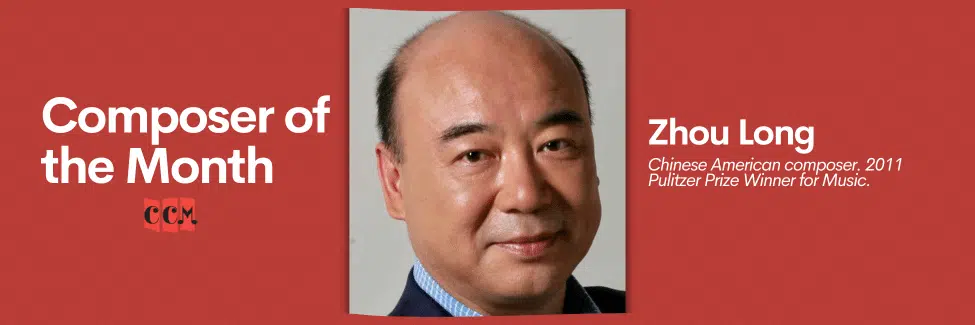
This November, we celebrate Zhou Long, a distinguished composer whose work masterfully blends Eastern and Western musical traditions. Long’s compositions offer a unique dialogue between the ancient musical heritage of China and contemporary Western techniques. His innovative approach makes him a significant figure in the world of modern classical music.
Early Life and Inspirations
Born in 1953 in Beijing, Zhou Long was surrounded by the rich heritage of Chinese traditional music. Growing up during a culturally vibrant yet politically complex time, he was naturally drawn to the arts. His initial exposure to music came through traditional Chinese opera and the ancient sounds of Chinese instruments. This early immersion in his culture deeply influenced his artistic direction!
As a young student, Zhou Long was fascinated by the music of his own culture, but he also showed a keen interest in Western classical music! At the time, his access to Western classical music was limited, but his curiosity prevailed. His intrigue led him to explore the works of composers like Beethoven and Mozart, whose structures and themes added a new dimension to his understanding of music. This blend of Eastern and Western influences during his formative years set the stage for his future as a bridge between these two worlds.
Long’s Music Career
Zhou Long’s career trajectory changed dramatically when he moved to the United States in the early 1980s to seek greater creative freedom. In the States, he began to study the avant-garde techniques of Western composition at Columbia University. Zhou studied under Chou Wen-chung, a pioneer in bridging Eastern and Western music philosophies. This period was crucial as it expanded his musical vocabulary and opened up new avenues for creative expression.
In the US, Long began experimenting with integrating Chinese musical concepts and instruments into Western classical frameworks, which became his signature style. His compositions during this period began to gain attention for their innovative synthesis of musical traditions. His success later earned him commissions from major orchestras and ensembles around the world!
Unique Aspects of His Music
Zhou Long’s compositions are characterized by their intricate melding of cultural elements. He often incorporates traditional Chinese instruments such as the pipa, erhu, and guzheng into symphonic compositions, creating a fascinating interplay of timbres and traditions. Moreover, his work frequently features pentatonic scales and traditional Chinese melodies reimagined within complex, contemporary harmonic structures.
This synthesis is not just about combining instruments or melodies but also about rethinking composition from the ground up. Zhou Long treats each piece as a cultural conversation, where every note and rhythm is a part of a larger narrative that bridges thousands of years of musical history.
Long’s Notable Works and Themes
Zhou Long’s most celebrated opera, “Madame White Snake,” earned him the Pulitzer Prize for Music in 2011. The opera is a testament to his ability to weave narrative, culture, and music into an engaging and modern composition. It tells a traditional Chinese tale through a score that combines both Western operatic form and Chinese melodic elements. This work showcases his dual mastery of these musical domains – a staple in his art!
Other significant works include “The Rhyme of Taigu,” which explores rhythmic patterns derived from ancient Chinese drumming practices, and “Song of the Ch’in,” which reflects the meditative quality of traditional Chinese stringed instrument music. Each composition not only serves as a piece of music but also as an exploration of cultural identity and expression.
Final Thoughts
Zhou Long is a composer who brings worlds together, creating a musical language that transcends geographical and cultural boundaries. His work challenges listeners to hear not just the convergence of East and West but the possibilities of new musical forms emerging from this fusion. As we feature him as our Composer of the Month this November, we celebrate his profound impact on the musical world and the continued relevance of his work in fostering global cultural understanding through music.
In celebrating Zhou Long, we acknowledge a visionary artist whose life’s work enhances our appreciation of the vast possibilities within the world of music. His compositions remain a vital part of contemporary classical music, enriching the global music scene with sounds that are both innovative and deeply reflective of his cultural heritage.

Arnold Schoenberg: October Composer of the Month
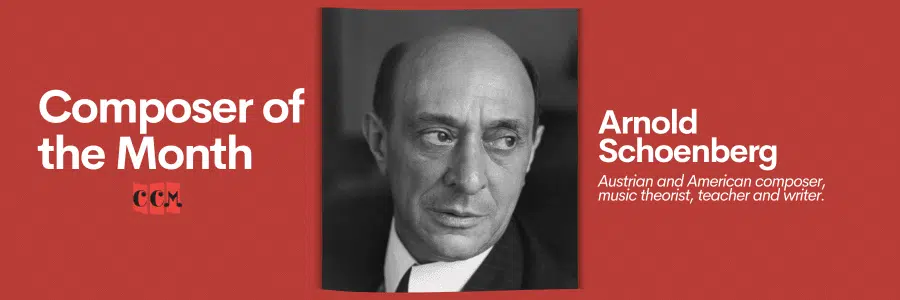
Arnold Schoenberg, a pivotal figure in the evolution of modern music, revolutionized the way we understand and appreciate classical compositions. Renowned for his twelve-tone technique, Schoenberg’s work challenges conventional musical boundaries. He effortlessly invites listeners into a world of complex, innovative soundscapes. This October, join us as we delve into his life and legacy. With his haunting melodies and depth shown in Pierrot Lunaire, he’s the perfect composer to learn about this spooky season!
Early Life and Inspirations
Arnold Schoenberg was born on September 13, 1874, in the vibrant cultural hub of Vienna, Austria. From an early age, Schoenberg exhibited a keen interest in music, though he was largely self-taught. The romanticism of prominent 19th-century figures Wagner and Brahms heavily influenced his initial musical explorations. As he matured, Schoenberg questioned the traditional tonal systems used by these musical giants, driven by his pursuit of innovation. Overall, his Jewish heritage and Vienna’s rich intellectual environment deeply shaped his musical philosophy, adding complexity to his works.
Schoenberg’s Music Career
Schoenberg’s career highlights his leadership in the Second Viennese School, mentoring luminaries like Alban Berg and Anton Webern. His shift from romanticism to atonality drastically changed his compositional style, challenging traditional musical aesthetics. In the early 1920s, he developed the twelve-tone technique, offering a new method to structure atonal music. This technique treated all twelve tones of the chromatic scale equally, fundamentally altering the structural basis of music composition.
Unique Aspects of His Music
Schoenberg’s approach to music was characterized by a rigorous, almost scientific method, yet it was deeply expressive and emotive. His compositions explored themes like existential angst and identity, challenging both the ears and minds of listeners. His theoretical writings on music still influence teaching and understanding today, affirming his unwavering status.
Notable Works and Themes
Among his vast repertoire, Pierrot Lunaire stands out for its textural richness and emotional depth. Composed in 1912, this melodrama features 21 settings of Albert Giraud’s poems, each depicting life and dreams through Pierrot. This work showcases Schoenberg’s use of atonality to boost expressive power without traditional harmonies. Other key works, Verklärte Nacht and Moses und Aron, explore transformation, morality, and faith. His music’s complexity and intellectual rigor make each listening a deeply reflective experience.
Expanding Schoenberg’s Influence
Beyond composition, Schoenberg’s influence extended into academia and pedagogy. He taught at the Prussian Academy of Arts and UCLA, influencing generations of composers and musicians. His teaching methods and philosophical approach to music education emphasized both technical skill and expressive capability, leaving a lasting impact.
Final Thoughts
Arnold Schoenberg remains a monumental figure in classical music, whose innovations laid the groundwork for much of modernist music in the 20th century and beyond. His fearless exploration of new musical territories, commitment to deep emotional expression, and profound impact on music theory and education highlight his enduring legacy. As we explore Pierrot Lunaire this October, we are reminded of the power of music to challenge, transform, and transcend. Schoenberg’s life and works continue to inspire and provoke, offering endless insights into the possibilities of musical expression.
Sign up for a FREE introductory music lesson at The California Conservatory of Music!

How to Practice Effectively & Consistently

Practicing music effectively goes beyond just playing notes correctly—it’s about deepening your understanding and enhancing your connection with the music. This guide is designed to help you get the most out of your practice sessions, ensuring they are as productive and enjoyable as possible!
Crafting Effective Music Practice
Good music practice is more than just a habit; it’s a strategic approach aimed at improving your musical skills efficiently. It involves setting specific goals, maintaining focus, and creating a structured routine. These components transform your practice from mere repetition to a valuable part of your musical development.
Setting Clear Goals
Start each practice session with specific, achievable goals. What do you want to achieve today? Whether it’s beginning a difficult piece, improving a technique, or practicing scales, having clear objectives will give your practice direction and purpose. Structure is crucial in making the most of your practice time. Divide your session into various segments—start with warm-ups, move on to technical exercises, dedicate time to pieces or songs, and perhaps conclude with some creative improvisation or sight-reading. This variety not only keeps your practice engaging, but ensures you’re developing a wide range of skills.
Prioritizing Quality over Quantity
Staying fully present during your practice session is vital. Pay attention to every detail of your playing or singing, making conscious adjustments and improvements. This focused approach helps you not only play the notes correctly, but also connect more deeply with the music, understanding its nuances and expressions.
Quality always trumps quantity when it comes to practicing. It’s better to have shorter sessions where you are completely focused and engaged than longer ones where your attention wanes. For example, a focused 10-30-minute session can often be more productive than a distracted two-hour stint.
Leveraging Music Practice Resources
Make use of the technology at your disposal! Metronomes help with timing, tuners assist with pitch accuracy, and recording devices allow you to listen back and critically evaluate your performance. These tools are indispensable for ensuring accuracy and providing feedback that’s essential for growth. Additionally, Practice Space is a music practice platform that has everything you need at your disposal. Receive multimedia assignments directly from your teacher, get your questions answered immediately, record your practice, and get rewarded for completion! Learn more about Practice Space here.
Embracing Feedback
Regular feedback is essential for improvement. Play for teachers, peers, or family members and listen to their input. Different perspectives can provide new insights and inspire you to refine your techniques further. Additionally, participating in group lessons or organizing family performances can offer valuable communal feedback. Treat mistakes as learning opportunities rather than setbacks. Analyze why an error occurred and experiment with ways to correct it. This proactive approach helps you overcome challenges and prevent similar issues in the future.
Effective & Consistent Music Practice
Consistency is key in building and maintaining musical skills. Try to practice daily, even if it’s only for a short period. Regular practice helps reinforce what you’ve learned and keeps your skills sharp!
Effective music practice is both a science and an art, requiring thoughtful organization and a genuine engagement with your musical materials. By incorporating these strategies into your routine, you can significantly enhance the effectiveness of your practice sessions. Always remember, the ultimate goal is to enjoy your music and continuously grow as a musician. Embrace each practice session with passion and dedication, and you’ll see great improvements in your musical abilities.
Sign up for a FREE introductory music lesson at The California Conservatory of Music!

Arturo Márquez: September Composer of the Month
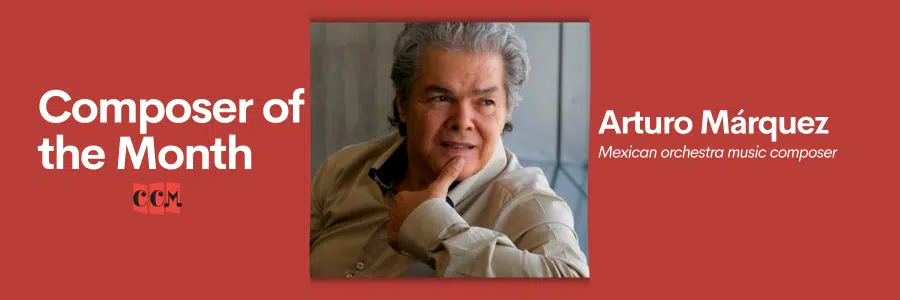
Arturo Márquez, a name synonymous with the vibrant rhythms and passionate melodies of Latin American music, is our celebrated Composer of the Month for September. He is world renowned for his ability to weave traditional Mexican folk music with orchestral arrangements. Márquez’s compositions offer a dynamic and colorful exploration of cultural identity through music. His works reflect his deep Mexican roots and his innovative approach to classical composition, making him one of the most influential contemporary composers from Latin America.
Early Life and Inspirations
Born on December 20, 1950, in Álamos, Sonora, Mexico, Arturo Márquez was immersed in a world filled with music from a young age. His father was a mariachi musician and his mother a singer, providing the initial sparks for his musical journey. From a household filled with music, Márquez received traditional mariachi, banda, and other regional style influences. These early experiences later impacted his compositional style, embedding the essence of Mexican musical heritage into his classical works. Márquez’s formal music education began at the Mexican Music Conservatory, and he later furthered his composition studies at the California Institute of the Arts.
Márquez’s Music Career
Arturo Márquez’s music career includes a successful blending of traditional Mexican music with orchestral elements. Before returning to Mexico, he studied in the United States and France with composeres Morton Subotnick and Jacques Castérède. Here, he began to experiment more profoundly with incorporating Mexican folkloric themes into his compositions. His works are often characterized by vibrant, rhythmic energy and lush melodic lines, leading to quick recognition. With his national and international acknowledgment, he is established as a key figure in the world of contemporary classical music.
Unique Aspects of His Music
Márquez’s compositions stand out for their rhythmic complexity and melodic richness, drawing heavily from his cultural heritage. One of the defining features of his music is the use of traditional Mexican dance forms, such as the danzón, which is evident in his most famous work, “Danzón No. 2.” This particular piece showcases his skill in transforming folk dance rhythms into sophisticated orchestral textures. Márquez’s music is both accessible and emotionally resonant, thus bridging between classical music audiences and the traditions of Mexican music.
Márquez’s Notable Works and Themes
Among Arturo Márquez’s most celebrated compositions, “Danzón No. 2,” premiered in 1994 is perhaps the most iconic. It has since become a symbol of Mexican music and culture, often likened to the second national anthem of Mexico. His “Conga del Fuego Nuevo” is another significant work, known for its lively and spirited traditional Mexican rhythms. Márquez’s music often explores themes of love, celebration, and national pride, painting an audible picture of Mexico’s rich cultural landscape.
Final Thoughts
Arturo Márquez’s contributions to the world of music extend beyond mere compositions. His works are a celebration of cultural identity. We can rely on Márquez to showcase the power of music to transcend borders and connect hearts. His works continue to inspire new generations of musicians and composers, illustrating that one’s heritage can profoundly enrich classical music. As we celebrate Márquez, we honor his outstanding musical achievements and the vibrant spirit of Mexico. Through his innovative blending of traditional and contemporary elements, Arturo Márquez challenges us to rethink the boundaries of classical music and to appreciate the rich tapestry of sounds that define our world.
Sign up for your FREE lesson at The California Conservatory of Music today!

How Substitute Music Teachers Elevate Lessons at CCM

When it comes to learning music, consistency is key. However, life is unpredictable, and there will be occasions when a regular teacher cannot make it to a lesson due to illness or professional commitments. At the California Conservatory of Music (CCM), while we strive to maintain regularity, we also embrace the invaluable benefits that substitute teachers can bring to a musical education. Here’s why having a substitute teacher can be a unique and enriching experience for students.
Fresh Perspectives & Techniques
Each teacher has a unique approach to music, drawing from their personal experiences and educational backgrounds. Substitute teachers bring new perspectives and techniques to the classroom, offering students a chance to explore different aspects of their musicality. Students will be able to receive new tips and re-enforcement that will further improve their musical experience. This variation in teaching style can help students adapt more flexibly to different instructions and methodologies, enhancing their overall musical proficiency.
Continuity in Learning
Our substitution policy ensures that a student’s learning progress is never halted. Missed lessons can disrupt a student’s progress, especially when preparing for performances or examinations. Substitute teachers provide continuity, ensuring that each student continues to advance even in their regular teacher’s absence. Plus, CCM teachers send notes to the substitute teachers, so that they can pick up where the student has left off with their progress. This commitment to continuous learning is crucial in maintaining the momentum students need to thrive.
Opportunity for Constructive Feedback
A fresh set of ears can offer new insights into a student’s performance and technique. Substitute teachers can provide constructive feedback from a new perspective, which is invaluable for growth and improvement. This feedback can help students identify areas they might not have realized needed attention, offering them an opportunity to refine their skills further. On the other hand, a substitute teacher can offer praise and encouragement that boosts the student’s confidence in their playing.
Inspiration and Adaptability
Substitute teachers often share their own musical journeys, experiences, and performances, which can be highly inspiring for students. Learning about different musical paths and careers can motivate students to explore new areas of music and set new goals for themselves. This can be particularly motivating for students who might be considering a future in music themselves.
Additionally, having different teachers can help students become more adaptable and resilient. Learning to adjust to a new instructor’s style and expectations, even for just one lesson, can foster flexibility and resilience. Plus, these traits prove to be beneficial both in and outside of music education! These life skills are essential as they prepare students to face various challenges they might encounter in their musical careers.
Final Thoughts
At CCM, we believe that every teacher, whether regular or substitute, brings something unique to the learning process. Substitute teachers ensure that learning continues without interruption while also offering fresh insights and inspiration. These experiences enrich a student’s journey and contribute to their overall growth as musicians.
Remember, every teacher at CCM, is dedicated to providing the highest quality of education and nurturing the musical talent of each student! By welcoming substitute teachers, we are all embracing a fuller, richer educational experience.
Sign up for a FREE music lesson at The California Conservatory of Music today.

August Voice Student of the Month – Rebecca Tachibana

This August, we’re highlighting CCM voice student, Rebecca Tachibana, as our Student of the Month! Rebecca has been taking voice lessons with teacher Michelle at our Redwood City location for around 4 months now. Teacher Michelle says, “Even though we have only started with lessons for [four] months, she has made progress and found the courage to discover her instrument—her voice!” Rebecca has been working on musicals, pop, and jazz songs, and teacher Michelle says she is always open-minded and a pleasure to teach. Keep up the amazing work, Rebecca!
Student of the Month Questionnaire – Rebecca Tachibana
What is your name?
Rebecca Tachibana
How old are you?
14
Who is your teacher?
Teacher Michelle
How long have you been taking voice lessons?
4 months
What advice would you give to a voice student just starting at CCM?
Don’t be ashamed/embarrassed.
What song are you looking forward to learning someday?
I don’t know yet.
What is your favorite thing about singing?
Just singing.
What is your favorite food?
Fish.
Do you have a pet?
2 cats.
Do you play any sports or do any other activities outside of music lessons?
No.
What do you want to be when you grow up?
Pediatrician.
What is your most memorable experience at CCM?
The class when my friends joined me.
Parent Spotlight – Michelle Tachibana
That she is pushing herself to achieve the goal set by her teacher.
Trust the teacher. Progress might be slow, but it is happening.
She always loved to sing, but she knew she needed help with her goal.

Zoltán Kodály: August Composer of the Month

In the world of classical music and music education, Zoltán Kodály is a name synonymous with innovation and influence. This August, we delve into the life and works of this Hungarian composer, ethnomusicologist, educator, linguist, and philosopher. His particular approach impacted music education worldwide!
Early Life and Inspirations
Zoltán Kodály was born on December 16, 1882, in Kecskemét, Hungary, and was immediately immersed in music. His mother played the piano, which was the first instrument he encountered, sparking a lifelong passion for music. Kodály’s early exposure to folk music, particularly the traditional melodies sung by his father and the local populace, deeply influenced his musical orientation. He pursued formal music education at the Budapest Academy of Music, where he met fellow composer Béla Bartók. Their friendship and mutual interest in folk music led to extensive travels across Hungary and neighboring countries. On these travels, they collected and analyzed thousands of folk songs. These experiences fundamentally shaped Kodály’s musical and educational philosophies.
Kodály’s Music Career
We can distinguish Kodály’s music career not only by his compositions, but also by his profound impact on music education. His early compositions were influenced by his deep research into Hungarian folk music. He worked to integrate these themes and styles into a classical framework. This period saw works like the “Psalmus Hungaricus” and “Dances of Galánta,” which celebrated Hungarian musical traditions and showcased Kodály’s innovative use of melody and rhythm. Next, his career took a significant turn towards education. His belief that music could and should be accessible to all was a driving force in this newfound passion. Alongside his compositions, Kodály developed a method of music education, known today as the Kodály Method. It emphasizes the importance of music literacy, ear training, and the use of folk music in primary and secondary education.
Unique Aspects of His Music
Kodály’s music includes a blend of traditional Hungarian folk music with classical forms. This synthesis that gave rise to a distinctly Hungarian classical style. He believed music was a social and cultural agent and could be used to foster a sense of identity and community. Furthermore, his approach to composition and education emphasized the importance of aural skills, including a strong focus on choir singing, which he considered fundamental for musical development. Kodály’s music often features intricate vocal lines and a deep attention to text setting, reflecting his background in linguistics.
Kodály’s Notable Works and Themes
Among Kodály’s most celebrated works is “Háry János Suite,” a musical portrayal of a Hungarian folk hero, which combines operatic elements with folk tunes, creating a vivid musical narrative that is both nationalistic and universally appealing. He wrote another significant composition, “Missa Brevis,” during the hardship of World War II. The piece has a flurry of emotional depth and structural mastery. Kodály’s works often explored themes of nature, folklore, and humanism, reflecting his belief in the power of music to transcend cultural and linguistic barriers.
Final Thoughts
In conclusion, Zoltán Kodály’s legacy is twofold. Through his compositions, he gave the world a treasure trove of music that reflects the spirit of Hungary. Additionally, through his educational methods, he influenced how music teaching styles globally and made it more accessible and enjoyable for students of all ages. His dedication to the cause of music education and his innovative approaches continue to inspire educators and musicians around the world. As we celebrate him as our Composer of the Month, we recognize not only his musical genius but also his visionary contribution to the world of music education. Kodály’s work remains a beacon for those who believe in the transformative power of music.
Sign up for a FREE introductory lesson at The California Conservatory of Music!

